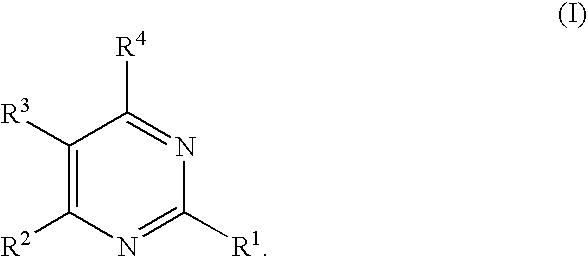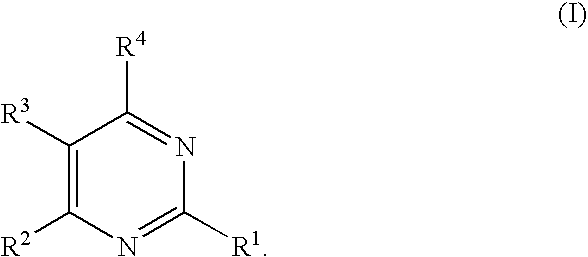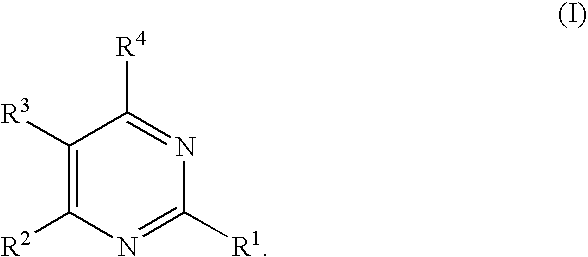Substituted pyrimidines
a technology of substituted pyrimidines and pyrimidines, which is applied in the field of substituted pyrimidines, can solve the problems of psychosis, overeating, sedation, and memory loss, and achieve the effects of reducing the number of side effects, and improving the effect of pyrimidines
- Summary
- Abstract
- Description
- Claims
- Application Information
AI Technical Summary
Problems solved by technology
Method used
Image
Examples
reference example 1
[0772]
4-Chlorobenzyl 2,4-dichlorophenyl ketone
[0773]A solution of 4-chlorobenzyl bromide (Lancaster Chemical) (10.0 g, 48.6 mmol) in 40 mL ether was added under nitrogen to a suspension of magnesium turnings (Alpha Chemical Inc.) in ether (60 mL) over 10 minutes. The suspension was stirred for 2 h and the supernatant was cannulated under nitrogen into another round bottom flask fitted with a magnetic stirrer bar. Then 2,4-dichlorobenzonitrile (7.0 g, 40.5 mmol) in 65 mL ether was slowly added under nitrogen to the Grignard solution and the mixture was stirred over night at room temperature. The imine precipitated out of solution and the mixture was refluxed for 3 h. The reaction mixture was cooled and poured into a flask containing 50 mL ethyl acetate and 50 mL 2N HCl. Stirred vigorously to hydrolyze the imine, separated the organic layer and dried it over anhydrous magnesium sulfate. The desiccant was filtered off and the solvent volume reduced under reduced pressure. The crude pro...
reference example 2
[0774]
3-Dimethylamino-1-(4-dichlorophenyl)-2-(2,4-dichlorophenyl)prop-2-en
[0775]To a solution of 4-chlorobenzyl 2,4-dichlorophenyl ketone (600 mg, 2 mmol) from Step A in DMF (8 mL) was added dimethylformamide dimethylacetal (1.05 mL, 8 mmol) over several minutes. The reaction was heated to 80° C. for 18 h. The DMF and excess acetal was removed under reduced pressure and the product used without further purification.
reference example 3
[0776]
2-Methylthio-4-(2,4-dichlorophenyl)-5-(4-chlorophenyl)pyrimidine
[0777]The crude product from Reference Example 2 was added to 5 mL pyridine and 1 mL water, along with 1.1 mmole (310 mg, 2.2 equivalents) pseudothiourea sulfate and triethylamine (460 μL, 2.8 mmol). The reaction mixture was heated to 80° C. for 4 h. The solvents were removed in vacuo and the reaction mixture dissolved in water. Extraction with ether gave crude product. Flash column chromatography on silica gel (eluted with 98 / 2 hexanes / ethyl acetate) yielded the desired product. HPLC / MS: m / e=382 (M+), 384 (M+2); Rt=3.48 min; 1H-NMR 500 MHz (CDCl3): δ 2.63 (s, 3H), 7.04 (d, J=8 Hz, 1H), 7.27 (d over multiplet, J=8 Hz, 4H), 8.59 (s, 1H).
PUM
| Property | Measurement | Unit |
|---|---|---|
| weight | aaaaa | aaaaa |
| weight | aaaaa | aaaaa |
| weight | aaaaa | aaaaa |
Abstract
Description
Claims
Application Information
 Login to View More
Login to View More - R&D
- Intellectual Property
- Life Sciences
- Materials
- Tech Scout
- Unparalleled Data Quality
- Higher Quality Content
- 60% Fewer Hallucinations
Browse by: Latest US Patents, China's latest patents, Technical Efficacy Thesaurus, Application Domain, Technology Topic, Popular Technical Reports.
© 2025 PatSnap. All rights reserved.Legal|Privacy policy|Modern Slavery Act Transparency Statement|Sitemap|About US| Contact US: help@patsnap.com



